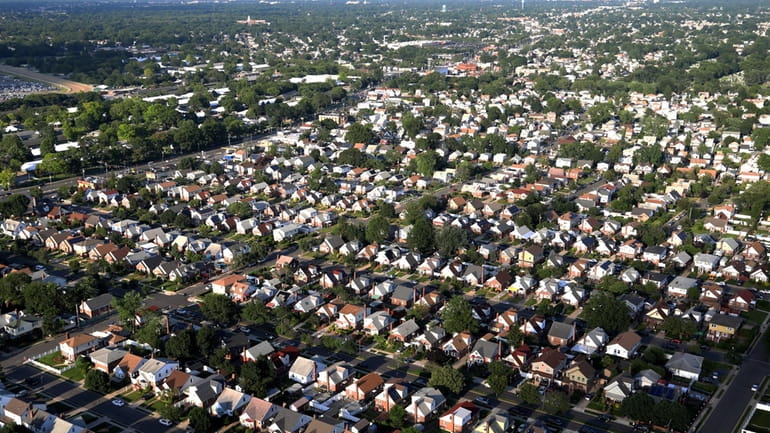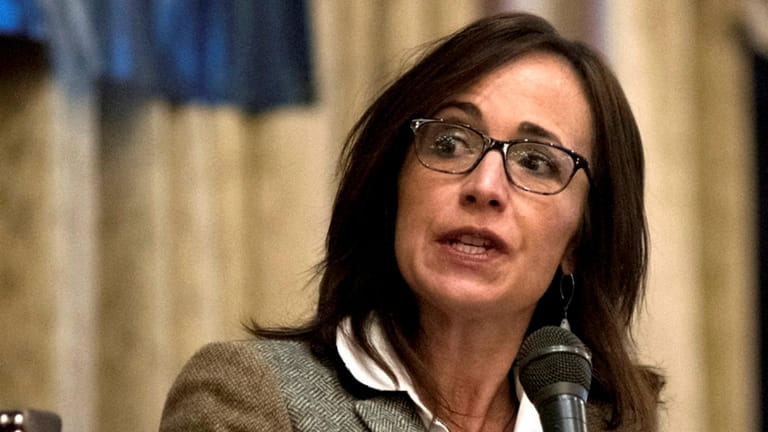Almost a third of Long Islanders with mortgages considered ‘cost-burdened,’ Census Bureau data shows
By Olivia Winslow and Arielle Martinez
Updated June 15, 2023 5:04 pm
Almost a third of Long Island homeowners with mortgages are considered “cost-burdened,” experts say, meaning they spend 35% or more of their income on monthly housing costs, according to U.S. Census Bureau data released Thursday.
The share of cost-burdened households was especially high among some of the Island’s minority groups, according to the data, which includes an array of economic characteristics broken out by race and ethnicity.
The large number of Long Islanders with mortgages and renters who spend 35% or more of their income on housing “speaks to the high costs of our region,” said Gwen O’Shea, president and chief executive of the Community Development Corp. of Long Island, a nonprofit that develops and manages housing units and promotes affordable housing.

A 2019 view of houses in Elmont. Credit: Newsday / John Keating
O’Shea said it was considered financially prudent to pay no more than 30% to 35% of one’s income on housing. She added, “35% to 40% is still manageable if you have a higher income.” But those with lower incomes, she advised, “You want to see them keeping that closer to 30%.”
Just over 29% of Long Islanders with a mortgage spend more than 35% of their income on monthly housing costs, which in addition to the mortgage includes expenses such as real estate taxes, utilities and condominium fees, according to data from the selected population tables in the Census Bureau’s 2017-2021 American Community Survey.
Sign up for the NewsdayTV newsletter
From breaking news to special features and documentaries, the NewsdayTV team is covering the issues that matter to you.SIGN UP
By clicking Sign up, you agree to our privacy policy.
The data includes information on median household income and poverty rates. Families headed by single women had a poverty rate higher than all families, an indication of the difficulty they face in Long Island’s economy. The poverty rate for all families on Long Island was 4%, compared with 11.8% for all female headed households with no spouse in the home.

It is considered financially prudent to pay no more than 30% to 35% of one’s income on housing, said Gwen O’Shea of the Community Development Corp. of Long Island. Credit: Johnny Milano
When looked at by race and ethnicity, female-headed households among American Indians/Alaska Natives had the highest poverty level, at 49.2%; Blacks, at 15.6%, Asians, at 12.2%, and whites, at 8.9%. Hispanics/Latinos, who can be of any race, were at 19.4%.
“Long Island is uniquely challenging for single female-headed households at a very basic level,” said Rebecca Sanin, president and chief executive of the Health and Welfare Council of Long Island. “We have one of the highest cost-of-living challenges statewide.”
Sanin cited child care as “prohibitively expensive,” plus the cost of housing and utilities.
“Single parents struggle tremendously because without two incomes, unless a person has considerable means, it’s very hard to live on Long Island,” she said.
The percentage of households with a mortgage that spent more than 35% of their income on monthly housing costs among Long Island’s Hispanic or Latino residents of any race was 33.7%. Among whites, it was 28.2%; for Blacks, 33.2%; Asians, 33.4%; and for American Indians/Alaska Natives, it was 29%. The “some other race” group on Long Island had the highest percentage, at 37.9%.
Among Long Island households overall without a mortgage on their homes, 21.1% spent more than 35% on monthly housing costs. Among whites, the percentage was only slightly higher, at 21.9%; among Blacks, 16.6%; Asians, 17.8%; and American Indians/Alaska Natives, 10.8%.
O’Shea, who hasn’t reviewed the Census Bureau data, said lower percentages spent on housing among those without a mortgage masks issues like seniors living on fixed incomes who might still feel burdened by the costs associated with their mortgage-free homes. Some may not have “a lot of cash on hand” to address home maintenance issues, for example.
Then they have to deal with increasing costs in many areas, she said. “There is still a discrepancy, in terms of an increase in costs and actual cash on hand in many, many households.”
According to the data, the percentage of renters who spent 35% or more on monthly housing costs was far higher than that of homeowners, 47% for Long Island renters overall. Among American Indians and Alaska Natives on Long Island, it was even higher — 63.4%. For whites, it was 46%; for Blacks, 48.3%; and Asians, 37.1%.
“There is a need for more affordable housing,” O’Shea said, admitting it was a “relative term.” She said a two-person household earning $125,000 a year can pay the rent but might be “challenged with becoming a homebuyer because they don’t have the closing costs or down payment to close that gap and get over the finish line.”
Previous 2017-2021 American Community Survey data has provided median household income and poverty rates, but the data available publicly Thursday provides race and gender details.
Recent Posts
June 28, 2024
Health and Welfare Council of Long Island hosts 2nd annual nonprofit job fair in Farmingdale
June 25, 2024
June 18, 2024
Categories
- 2020 Census 9
- Coalitions 4
- COVID-19 10
- Direct Services 4
- HEALI 3
- Health Equity 4
- Healthcare Access 6
- HWCLI 74
- LIVOAD 9
- Press Release 3
- Uncategorized 6
- Weekly Digest 3
Join us in creating a future for Long Island in which everyone has an equal opportunity to prosper and thrive.
Join Our Network
Subscribe to Our Newsletter
Copyright ©2024 HWCLI. All Rights Reserved. Designed by FBC
